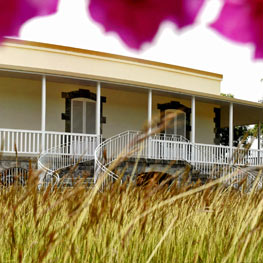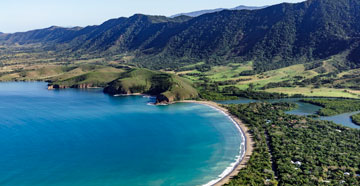Pouembout is a village situated at the heart of the Caledonian bush, a brightly coloured setting worthy of the American Far West. The history of the village, like several others in New Caledonia, is strongly linked to the archipelago’s time as a penal colony. The American presence during the Second World War also had a profound effect on the environment here.
In addition to the Plaine des Gaïacs, Pouembout enjoys beautiful beaches, including Pindaï and Franco, and is home to the 100m high Ouendé waterfall, although access to this, since it is located in a tribal area, requires authorisation. In October a horticultural show comes to remind us of the deeply agricultural character of the village...
The Plaine des Gaïacs, a huge area which today is almost uninhabited, in fact played a strategic role for American troops facing Japanese forces in the Second World War.
In order that New Caledonia, then still lacking in infrastructure, could play the role the Americans had determined for it, namely to be a giant aircraft-carrier, the construction of aerodromes proved to be crucial.
When Pouembout was an American military aerodrome...
This is how the Plaine des Gaïacs became the recipient of two runways and saw thousands of aeroplanes at this base, mainly from 1942 until the end of 1943.
While the presence of the Americans has left an indelible mark, Pouembout’s foundation dates from 1883, when a centre for the penal colony was created. At that time the penal administration already owned more than 3,500 hectares of land. The black earth of the region is in fact considered the most fertile in the territory. Vestiges do remain from the time of the penal colony: the Grimigni Château (built in 1886 and renovated in 2006) and the Pigeonnier, two symbolic buildings which retrace the history of the village.
From the Pindaï beach to the Ouendé waterfall...
For around twenty years the penal colony remained very isolated from the rest of the territory. It was only at the start of the twentieth century that the mule path linking Pouembout to the village of Koné would be turned into a passable road, and that a landing stage built at the mouth of the river would enable food supplies to be delivered by sea.
- Nouméa Tourism Office
- Opening hours: Quai Ferry from Monday to Friday : 8:00-10:30, Saturday : 9:00-15:30. Anse Vata every day : 9:00-12:30 & 13:00-17:00.
- Telephone: +687 28 75 80
- Email: info@office-tourisme.nc

- Dumbéa
- Boulouparis
- La Foa
- Farino
- Moindou
- Bourail
- Koné
- Voh
- Kaala-Gomen
- Koumac
- Poum
- Païta
- Poya
- Bélep
- Sarraméa
More than 130 years after the creation of the agricultural penal colony, Pouembout remains one of the most important ‘granaries’ in New Caledonia. Immense cultivation, stretching from the lagoon up to the central mountain range, would enable significant production of fruits and vegetables, including delicious melons. The location here of a professional farming school attests to its role as a fertile ‘agricultural capital’. Other specialities (deer, dogfish, oysters and crabs) complete the local production...
Discover the must-sees in Pouembout
Voir plusAerodrome & memorial of the Plaine des Gaïacs
New Caledonia knows generally how much it owes to the American presence during the Second World War. The allied troops made a large contribution to the dev...
Read moreThe coastal path at Pindaï
This walk of nearly three hours follows the coastal path from the beach at Pindaï as far as the port of Népoui, facing the Grimaud islet.
Read moreChâteau Grimigni
The history of the village of Pouembout started in 1883, when the decision was taken to build a penitentiary. It was to extend over nearly 3,500 hectares. ...
Read more













